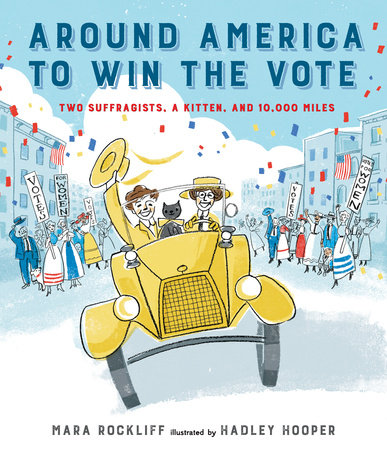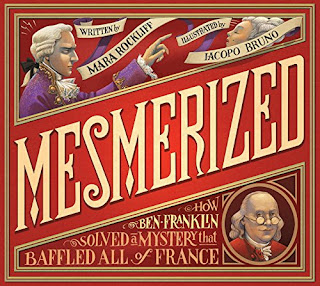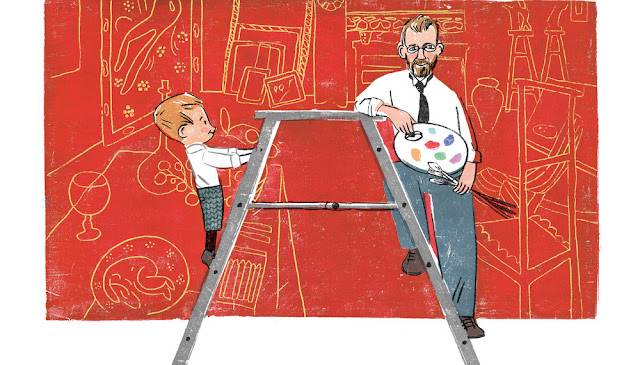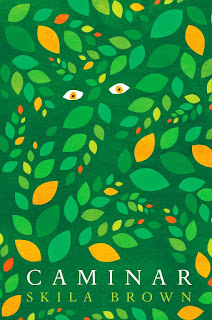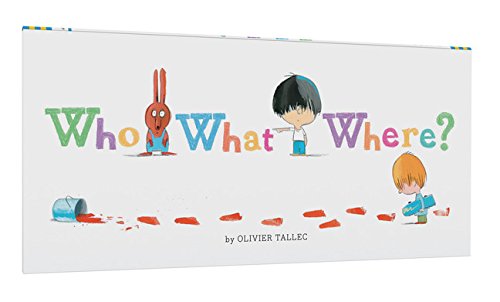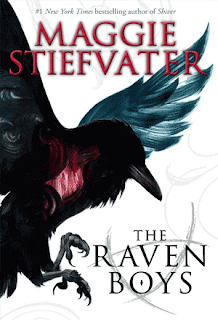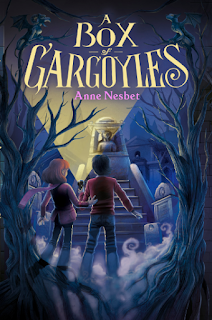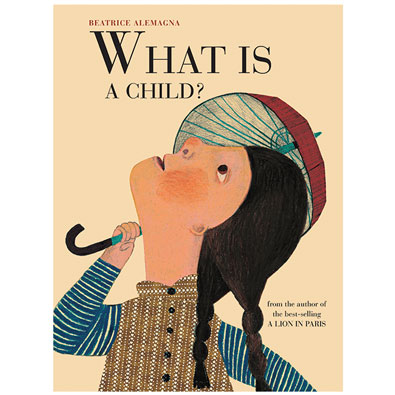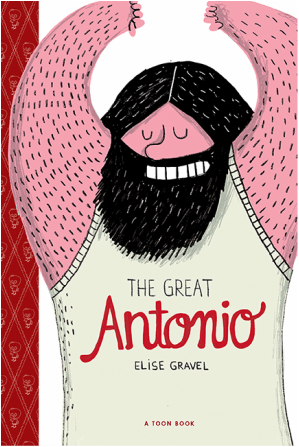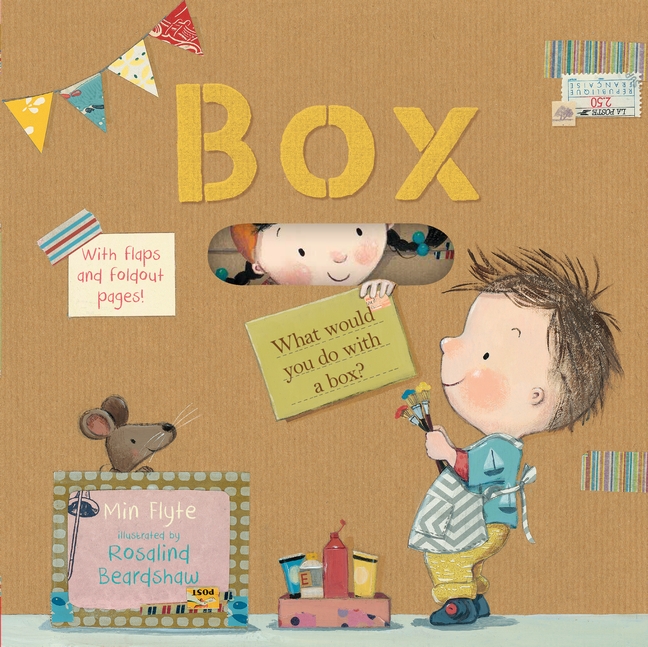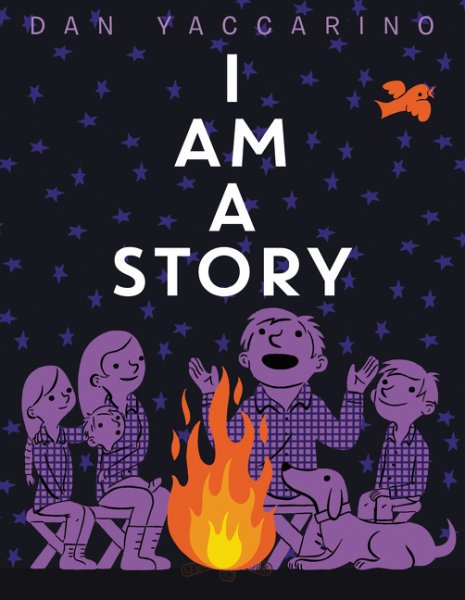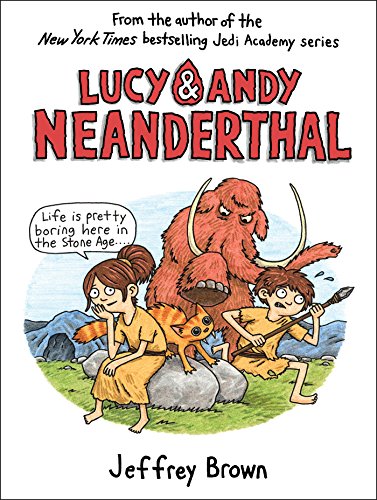new posts in all blogs
Viewing Blog: Children's Book Reviews and Then Some, Most Recent at Top
Results 1 - 25 of 1,820
.jpeg)
As a lover of children's literature, mother and bookseller of 13 years, I want to put good books into kid's hands. I share my philosophy on what makes a book good as well as book reviews and lists of great books for every reading taste and ability with a focus on new readers. I also highlight some wonderful books that are not always on the shelf at bookstores, but might be at your library and can definitely be ordered. All books mentioned are available in paperback unless noted.
Statistics for Children's Book Reviews and Then Some
Number of Readers that added this blog to their MyJacketFlap: 20
Vincent's Starry Night and Other Stories: A Children's History of Art perfectly pairs writer, art historian and radio broadcaster Michael Bird with the London based Laurence King Publishing, one of the world's leading publishers of books on the creative arts, acclaimed for their inventiveness, beautiful design and authoritative texts. From a cave in Germany 40,000 years ago to 21st century artist Ai Weiwei, Bird divides the history of art into eight periods, traveling the world from Cambodia to Egypt, Europe, China and New York City, featuring the stories of more than 68 artists. The photographed art of featured artists is paired with illustrations by Kate Evans that help tell the stories that Bird uses to tell the stories of the art and the artists.

Vincent's Starry Night and Other Stories: A Child's History of Art can be read from cover to cover, the narrative is so entertaining and engaging. I could easily see this book being bedtime reading for many families. After all, art is a form of visual story telling. Bird has a way, sometimes playful, of putting the reader in the room with the artist. Chapter 33, which features Diego Velázquez and his 1656 painting The Maids of Honor, begins, "'Boo!' Diego Velázquez jumps. His brush leaves a black smudge on his forehead - that is, the forehead of his own portrait, which he is painting just here, to the side of his enormous painting of the royal family. He turns to see five faces looking up at him." The little Princess Margarita Teresa and her maids of honor, along with their companions, the dwarfs Maria and Nicolas. In the part Revolution! 1750 - 1860, Bird puts readers on the dangerous streets of Paris when Jacques-Louis David learns of the murder of his friend Marat and how he comes to compose his famous portrait of the radical journalist and Revolutionary politician. From David, we find Goya in Spain and his decision to paint the violence, suffering, and helplessness of his people amidst the chaos of the time.

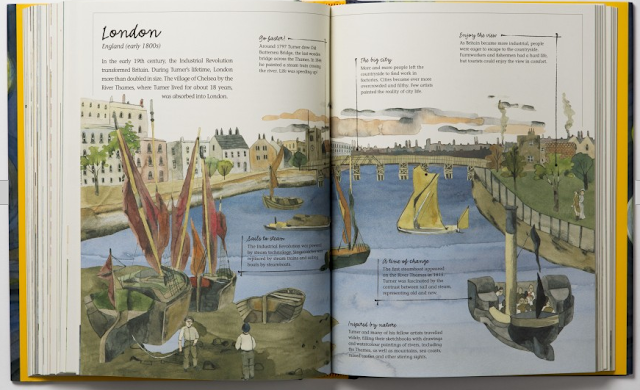
Occasional maps place the artists and their art as well as give a feel for the time period. His narratives also help make sense of some modern art, the meaning and important of which might escape many of us. Chapter 54 finds Marcel Duchamp, sitting on a park bench in New York City as World War I raged on, reading a letter from his sister, a nurse in Paris. She is cleaning out his studio and he wonders what she has done with his piece, Bicycle Wheel. Interestingly, the original was lost in 1913 and what we see today are replicas. The rest of Duchamp's story about what he thinks defines art and the ways in which his ideas challenge those of most others. Vincent's Starry Night and Other Stories: A Children's History of Art ends with Ai Weiwei and his Sunflower Seeds installation. For his final story, Bird imagines a brother and sister visiting the work in 2011. Told not to touch the porcelain seeds by a guard, the older sister decides to research the artist and make her own seed. The story ends with a Google search and a view of Weiwei on CCTV as he opens the front gates of his home in Beijing, where he is still on house arrest. A poignant ending to a marvelous book that should sit on the shelf of every child's room. If you take nothing else away from Vincent's Starry Night and Other Stories: A Children's History of Art, even if we don't understand a work of art, ultimately art helps us understand what it means to be human.

Source: Review Copy
Beatrix Potter and her books were a meaningful part of my childhood. As a child, I loved all things tiny - and what's not to love about a tidy little pile of green books with white trim? Especially when the illustrations inside carry you away to a magical world that exists behind hedges, under piles of oily-tasting mown grass and near the damp edges of a pond dotted with lily pads? As a parent reading her books to my children, it was harder to make sense of her strange world, although the illustrations and curious ways of the animals remained transportive enough to make me very excited to get my hands on A Celebration of Beatrix Potter: Art and Letters by More than 30 of Today's Favorite Children's Book Illustrators.

Beyond the obvious attributes that keep Potter's books on the shelves 100 plus years after her debut, The Tale of Peter Rabbit, which was originally self-published, are the facts of the woman herself. Born in 1866 and growing up in the Victorian era, Potter was fiercely independent and "unwavering curiosity led her to become a cryptographer, an amateur scientist, an award-winning farmer, a political activist, a revolutionary conservationist and a forward thinking business woman." Pretty spectacular accomplishments for a woman of wealth in an era when women were expected to follow rigid social structures. This celebration of Potter and her 150th birthday is a delight for anyone who is a fan of contemporary children's book illustrators.


From favorites of mine like David Wiesner, Chris Haughton, Jen Corace, Renata Liwska Brendan Wenzel, Dan Santat and Tony DiTerlizzi, to greats like Rosemary Wells, Peggy Rathmann, Wendell Minor, Brian Pinkney and Tomie de Paola, fans of Potter will absolutely delight at their renderings of favorite characters. Nine of Potter's books are featured here, with portions reprinted, along with a brief paragraph about the origins of each book and remembrances from contributors. I completely enjoyed flipping through the pages, seeing Potter's originals next to new interpretations and being transported one more time to that world behind the hedgerow. Such a treat!
Source: Review Copy

Earlier this year I enthusiastically reviewed the marvelous debut picture book from Daisy Hirst, The Girl with the Parrot on Her Head. Hirst's book subtly, thoughtfully and genuinely addresses the emotions of loneliness, anger and fear in a small child while simultaneously creating a setting and story that captures the imagination, creativity and curious logic of children. And, as with all the best picture books, Hirst makes this all seem effortless. Whatever countless hours, months and years of work that went into creating her picture book become an seemingly effortlessly engaging, charming story that leaves readers and listeners with so much to talk about. Hirst accomplishes the same magic with her new book, Alphonse, That Is Not OK to Do!, a sibling story that is a joy to read. In fact, I read it over and over to kindergarten, first and second graders the week before writing this review and I discovered something new and wonderful about the book with each reading. And, as with her debut book, Hirst's new picture book gives readers and listeners so much to think and talk about.
Alphonse, That Is Not OK to Do! begins, "Once there was Natalie," and we see a happy red monster swinging as she holds her parents's hands. A page turn brings the arrival of Alphonse. While Natalie's facial expression is less than cheerful, she, "mostly did not mind there being Alphonse." We see the two playing together, making things together and naming pigeons together, but we also learn that sometimes Alphonse draws on things Natalie has made and occasionally eats her books, which she hates.

One day, when things aren't going well for Natalie, Alphonse sends her over the edge. She finds him under the bed, eating her favorite book. If you look closely you will notice that Alphonse is eating A Bargain for Frances by Russell Hoban which, Hirst's bio reveals, was her favorite audio book as a child. She tells him that is not OK to do, then draws an angry picture in which a tiny Alphonse is being assailed by "a tornado, two beasts and a swarm of peas." Alone in her bath, Natalie becomes worried when she thinks she hears her drawing come to life. In a very clever twist that took me a reading or two to notice, the sounds that Natalie hears (which are being made by Alphonse as he tries to get the tape to repair Natalie's book down from a high shelf with the vacuum then a chair) do actually echo the sounds that her drawing might make. Natalie is scared, and remorseful. A two page spread shows her at the right corner of the recto, wrapped in her towel and looking worried. A page turn reveals the scene below.

Hirst ends her book with an explanation and apology from Alphonse, which Natalie responds too with sweet concern and her own apology for being mean. Alphonse then shows Natalie that he finished her picture and her expression is one of trepidation. Happily, she thinks it is "Most Excellent Fantastic!" and the two go on to draw more together.
I realize that I basically told the whole story of Alphonse, That Is Not OK to Do! here, but I wanted you to get a feel for the excellent story telling on display as well as the superb, caring character that is Natalie. There are teachable moments in this book and moments where you will want to stop and talk with the listeners. Best of all, there are no adults in this book, allowing Natalie and Alphonse to work things out themselves, which is so much more powerful than having mom or dad come in and sort things out.
For a glimpse into the long process of writing this book, and the collaborations along the way that shaped it, read Hirst's contribution to Picture Book Party, a blog by Walker Books UK, partner with my favorite publisher of picture books, Candlewick Press.
The Girl with the Parrot on Her Head
It feels right on this day when we could elect our first woman president to post a review of a book about two women who, 100 years ago exactly, spent five months driving around America - 10,000 miles! - crusading for women's voting rights. Using newspaper articles about the women and their journey, Mara Rockliff tells their story (fact checking when necessary) with illustrations by Hadley Hooper that combine pencil drawing and printmaking with a largely yellow palette (the color that stood for Votes for Women) that is dynamic and engaging, making Around America to Win the Vote: Two Suffragists, a Kitten, and 10,000 Miles a highly readable book.

In fact, Around America to Win the Vote is such a fun read that I almost forgot the serious nature of the what Nell Richardson and Alice Burke set out to do when the drove off from New York City in their "little runabout" made by the Saxon Car Company. However, this also reminded me of one of the great things about narrative non-fiction picture books and how they can hook readers and spur them onto further reading and research. By the time Nell and Alice arrived to a grand welcome back in New York City, I was ready to get to the author's notes, which were equally fascinating.
Rockliff's narrative focuses mostly on the journey itself, and the many ruts and rivers the Saxon seemed to get stuck in. The women brought a typewriter and a sewing machine with them, bringing them out at rallies to show that they had the brains to vote (Nell would write a poem, proving they did) and that they could take care of domestic duties AND play a part in running the nation (Nell would sew an apron while Alice gave a speech.) In places where men didn't want to hear about votes for women, Alice and Nell would instead discuss the inner workings of their car. Part of Rockliff's historical notes put into context the significance of driving a car across the country - and back - in 1916, just thirteen years after the first successful cross-country trip (which did not include the return trip.) In her back matter, Winning the Vote, Rockliff starts in 1776 with a letter from Abigail to John Adams asking him to "remember the ladies," to which he laughed, going on to sign the Declaration of Independence, stating that "all men are created equal." Rockliff also shares fascinating facts about protests women staged in 1916, including a "walkless parade" in St. Louis that left men on their way to the Democratic convention forced to pass between the eight thousand, silent suffragists lining the streets for a mile on both sides.

Also by Mara Rockliff:
Also by Hadley Hooper:
Source: Review Copy

If you are new to Princess Magnolia and her alter ego, the Princess in Black, while you do not really need to read these books in order, DO NOT start with The Princess in Black Takes a Vacation! There is a major plot surprise (oh, okay, I saw it coming in the first book. . .) and something new for Princess Magnolia and Frimplepants, a.k.a. Blacky, her faithful steed. The delight I (and, quite happily, my students) take in these marvelous, magnificent, spectacularly illustrated books is immense. The Princess in Black series allows us to enjoy the best of both worlds and all that is (mostly) great about being a girl today. We get to see the castle, the tea parties, the froufrou pink dresses and the wild princess parties (Book 2, The Princess in Black and the Perfect Princess Party, happens to be my favorite) and we also get to see the Princess in Black don a mask and give monsters some serious smackdowns with awesome moves like the Serpent Slip, the Forehead Crash and Twinkle Twinkle Little Smash. Best of all, Hale, Hale and Pham have created highly engaging books that are ideal for emerging readers, books I like to call "bridge books." They are the perfect step up for kids who are ready to move up from leveled readers like Frog & Toad and Fancy Nancy but not yet ready for traditional chapter books like the Magic Tree House and Junie B. Jones. The font is large, the illustrations are generous and the page count is around 90 in this series.
I can't go on enough about how much I live The Princess in Black series and I hope it never ends. I received my review copy of The Princess in Black Takes a Vacation about two weeks before the publication date. I knew I just had to bring it to the library, where we have four copies of each of the first three books in our collection but rarely on the shelf, even though I hadn't read it yet. A second grader spotted, squealed and asked me to PLEASE read it to her. It was a hectic recess period, so we leaned against the circulation desk and read the first six chapters. Other girls crowded around when they saw what we were reading. At lunch recess, we had the luxury of plopping down on the dusty old purple couch in the library and reading the next three chapters. We finished the book the next day and I put it into circulation. Now the hard part comes - having only one copy of The Princess in Black Takes a Vacation on the shelf until my order of three library bound copies comes in!
The Princess in Black Series
Source: Review Copy
The saga of the Donner Party is fascinating to me, perhaps because I am a native Californian. More likely because, as an adult, I read Nathan Hale's excellent graphic novel recounting this story of survival, Donner Dinner Party. Despite the witty title, Hale handles the gruesome events with tact and respect for his young audience. He also shares so many facts that I had not known before, like the fact that George Donner murdered a man in anger during the journey and that one young member of the party actually died from overeating just after being rescued. While Hale's graphic novel is packed with facts, in To Stay Alive, Skila Brown masterfully uses the verse novel format to explore this story from the perspective of Mary Ann Graves, who was nineteen when the novels begins.
The second oldest child in a family of nine, Mary Ann and her family leave Lacon, Illinois with three horses, twenty head of cattle, eighteen oxen and three wagons. There are thirteen in the Graves party, including Jay Fosdick, oldest child Sarah's husband, and John Snyder, a hired hand who is stabbed to death by an irate George Donner before the snows even set in. While Hale, with an omniscient narrator, is able to share all aspects of the Donner Party, their struggles and outcomes, Brown's book gives us only Mary Ann's experience with an author's note at the end recounting the fates of the others. In doing this, Brown is able to have Mary Ann comment on the experience of being a woman in 1846. While expected to work as hard as the men, especially because she is not a child, her opinion means nothing, she has no say. In the poem, "In the Canyon," after the men have made the ill-fated choice to take Hasting's Cutoff, promised to be a well traveled shortcut, but really a forest, Mary Ann thinks,
Each time I push on a rock, I think
that these men in our camp
cannot admit when they're wrong.
Each time I snap off a limb, I think
that those men at the fort
did not know a shortcut, had us make one instead.
Each time I pick up a load of brush that scratches my face, I think
how much easier it will be for those who come
next year, now that we've made a path.
Divided by the four seasons with Winter being the longest section, To Stay Alive is completely gripping, but also hard to read if you are familiar with the history of the Donner Party. However, Mary Ann's strength of character and intelligence, as portrayed by Brown, kept me reading throughout the bleak and startling poems, many of which combine form and words in dynamic ways that allow you to feel the extreme jostling of riding in the wagon or the rush and flow of the Humboldt River or the intense pain of the cold and the blinding white of the snow. Fabric, sewing and specifically quilting was a theme in To Stay Alive that I felt was especially powerful. In fact, the first poem of the novel is, "New Dress" where Mary Ann describes her newly made travel dress,
thick and crisp and green,
white buttons in a line,
a bright stiff collar, perched high.
It's a dress for adventure,
a dress ready for
whatever it will face.
Strongly stitched, unspoiled, new,
well made.
It is meant to endure.
By the end of the novel, this enduring new dress is much like Mary Ann herself, stained from the blood of the Graves' last heads of cattle they slaughtered for food, stained from the blood of a deer she and William Eddy killed while trying to make their way over the mountain pass. Mary Ann notes that fabric of her green dress is, "stiff again - / not from newness, but from / something else, something that won't let it bend," as she tears strips of it off with her teeth, using it to bind and protect her feet, which are bleeding and aching after thirty-two days trying to make it to Sutter's Fort. She recoils "at the stench of her dress." Over the course of their journey, Mary Ann had been sewing a quilt. She leaves the finished quilt behind at Truckee Lake when she joins the party that will leave camp and ultimately find help. It is this same quilt that her youngest brother is wrapped in, buried in the mountains, in their Mother's arms. In Brown's version of Graves's story, Mary Ann spends her four months of recovery at Sutter's Fort sewing a new quilt, one made from the gray remnants of her clothing.
It is a field of gray,
a wall or worn-out worry,
patches and patches
of sewn-together sorrow.
But that is only the background.
on top of there is a rainbow of life,
a tapestry of creatures,
a forest of hope,
for I used brightly colored threads.
To Stay Alive is a powerfully told story of survival, made even more so by Brown's crafting of the poems that make up this novel. I look forward to the next subject that she chooses to turn her poetic sights to.
Source: Review Copy

Joyce Sidman and Beth Krommes have a way with creating meditatively beautiful books that make you slow down and think about the world around you. Their works are like the picture book equivalents of a deep, cleansing breath. With their newest book, Before Morning, they visit the magical world of a snow day. I say magical because, as a native Southern Californian, a snow day seems extremely exotic and unattainable, almost like getting to visit Santa's workshop or Dumbledore's office.
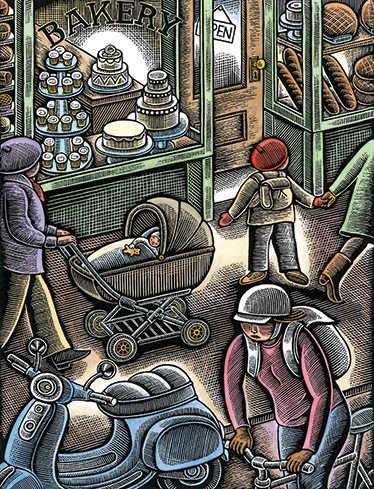
Before Morning begins with eight pages of illustrations that show us a mother and child walking home through a bustling city as night falls. Entering their apartment, we see the table is set for dinner, and parents are hugging, yet the look on the child's face is one of sadness. The final page of illustrations before the text begins shows the mother sitting on her child's bed saying goodnight. She is in a pilot's uniform and a book about Amelia Earhart is on the child's bed. It is time for her to go to work. A page turn reveals the words, "In the deep woolen dark, as we slumber unknowing, let the sky fill with flurry and flight." As an afterword from Sidman tells us, Before Morning is written in the form of an "invocation - a poem that invites something to happen, often asking for help or support." As the wonderful poetry of Sidman's text flows on, she asks that the "air turn to feathers, the earth turn to sugar," as she asks for snow to fall. We see the city dwellers cope as their world is blanketed in white and we see anxious, weary travelers at the airport, watching the snow fall out the windows as Sidman asks to let "urgent plans founder," and let "pathways be hidden from sight." As the story goes on, readers will realize that the invocation is from (or for?) the child wishing for the mother's return and having that wish granted. "Please - just this once - change the world before morning: make it slow and delightful . . . and white." The final illustrations show the family happily reunited and heading out into the newly white world for a day of sledding.

One thing I especially like about Krommes's scratchboard illustrations are the almost genderlessness of her characters, allowing readers to imagine a boy or a girl child awaiting her mother's return. I wish I lived in a snowy place and my kids were small again so that we could read Before Morning together, cozy in bed, on a night when snow has been promised, falling asleep and hoping to be greeted by a snow day in the morning - the gift of a pause in our busy lives. A deep, cleansing breath.
More books by
Joyce Sidman & Beth Krommes:
Source: Review Copy
 Last Year I enthusiastically reviewed the curiously out of the ordinary picture book Who Done It? by Olivier Tallec. Everything about Tallec's book was fun and funny. Tallec brings back the same cast of characters and more mysteries to be solved in his newest book Who What Where?
Last Year I enthusiastically reviewed the curiously out of the ordinary picture book Who Done It? by Olivier Tallec. Everything about Tallec's book was fun and funny. Tallec brings back the same cast of characters and more mysteries to be solved in his newest book Who What Where? With a spine on the horizontal, the format makes you lift the cover and hold the book in a different way, a way that lends itself to the story inside. Tallec's questions are not as easy to answer as they seem at first. Readers will pore over illustrations trying to figure out who chose the rug for a hiding place, who is looking in the mirror, who is playing ghosts and who jumped a little too much on the bed. The crime scene is at the top of the fold with the line up of possible perps below it. Tallec's bright palette and fantastic facial expressions on his humans and animals make Who What Where? a real gem. Be sure to find either or both of these books by Tallec and be ready to have a very fun time reading with your little one.
With a spine on the horizontal, the format makes you lift the cover and hold the book in a different way, a way that lends itself to the story inside. Tallec's questions are not as easy to answer as they seem at first. Readers will pore over illustrations trying to figure out who chose the rug for a hiding place, who is looking in the mirror, who is playing ghosts and who jumped a little too much on the bed. The crime scene is at the top of the fold with the line up of possible perps below it. Tallec's bright palette and fantastic facial expressions on his humans and animals make Who What Where? a real gem. Be sure to find either or both of these books by Tallec and be ready to have a very fun time reading with your little one.
Source: Review Copy
The Raven Boys by Maggie Stiefvater came out in 2012 to rave reviews and awards. The fourth and final book in The Raven Cycle, The Raven King, just came out this April. I'm a pretty late to this bandwagon, but if you are not already on it and you like psychic phenomena, Welsh kings and/or private school boys, jump on NOW.
When I was a kid, I was fascinated by the psychic world and, slightly less so, the spiritual world. ESP and ghosts were my thing, with maybe some spells thrown in. This was well before Harry Potter, the Long Island Medium or Wiccan being an (almost) household word, so I was not especially well informed. But, The Raven Boys should be deeply satisfying to any young reader today with similar tastes. I know my 13-year-old self would have been obsessed with it and probably slept with it under my pillow.
16-year-old Blue Sargent lives at 300 Fox Way in Henrietta, Virginia with her mother, Maura, and assorted aunts, cousins and friends, all of whom are women who have assorted psychic abilities, and all of whom have agreed that, "If Blue was to kiss her true love, he would die." Blue is not too bothered by this, deciding that she will never fall in love. The Raven Boys begins with Blue and Neeve, Maura's visiting half-sister who is a celebrity psychic, sitting in a churchyard as midnight approaches, waiting for St. Mark's Day and the trail of spirits who will die in the next twelve months to come walking along the Corpse Road. Blue, while having no psychic powers of her own, does seem to act as an amplifier for the powers of those near her. As the spirits arrive and Neeve sees them, asking their names so Blue can write them down, Blue realizes that she can see one of the spirits. She is shaken by how young he is and asks him his name (it's Gansey) noticing that he is wearing the sweater of Aglionby,(pronounced, according the the audio book and Stiefvater's twitter feed, AGG lyn bee) the local boarding school for the children of politicians and other wealthy types. Neeve tells Blue that there are only two reasons a non-seer would see a spirit on St. Mark's Eve, "Either you're his true love, or you killed him."
Do you even need to know more? The raven is Aglionby's mascot, as well as the bird of Glendower, the Welsh king who Gansey (of the dying spirit) believes is interred somewhere near Henrietta. The Raven Boys of the title are Gansey and his three friends, Ronan, Adam and Noah. Stiefvater does as masterful job crafting these palpably real characters and bringing the town of Henrietta, with its ley lines and other magical hot spots, to very vivid life. Gansey is sort of a trust-fund-teenaged-Indiana Jones who has a knack for finding artifacts, a knack that has led him to Henrietta and Aglionby Academy, drawing a circle of friends around him, through his charisma, wealth and genuine passion, that will work together to find Glendower. Buy the book (or the audio, marvelously read in a gently musical Southern accent by Will Patton) and buckle up for a long ride down a country road in the Pig (Gansey's classic Camaro) that you won't want to end.
Once you do begin reading The Raven Cycle, be sure to check out this website: Recaptains, which is dedicated to reminding readers what happened in the last book in a series before beginning the next one. And be warned, this site is riddled with spoilers. But, if you've already read these books or don't mind spoilers you HAVE to read the summaries of the first three books written by MAGGIE STIEFVATER HERSELF!!! She is HILARIOUS while also writing a masterful summary of her books.
Source: Purchased Audio Book
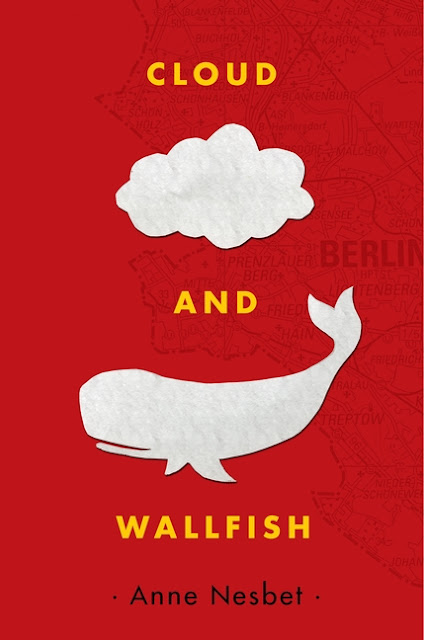
I reviewed and really enjoyed Anne Nesbet's debut novel, The Cabinet of Earth. It was exciting to read a middle grade fantasy novel set in Paris and I found the magic that Nesbet created for this story exciting and out of the ordinary. Nesbet followed with A Box of Gargoyles, a companion to her first book, then The Wrinkled Crown, another fantasy with the feel of a traditional fairy tale, albeit one with political undertones. It surprised me to find that Nesbet's new book, Cloud and Wallfish, is set in East Germany in 1989 and centers around the hard won friendship between an American boy with a paralyzing stutter and a curious girl who has been sent to live with her grandmother. Like what I imagine life in the German Democratic Republic prior to the fall of the Berlin Wall must have been like, Cloud and Wallfish is a quiet, secretive book that requests patience from readers. This patience will be rewarded, like the page turn that reveals the meaning to the title of this marvelous book, but some questions will never be answered.
Cloud and Wallfish begins in Oasis, Virginia in May of 1989. Noah Keller has almost finished fifth grade when his parents pick him up from school and completely turn his life upside down. Everything with his name on it is thrown into a trashcan at a rest stop on their way to the airport. They are headed to East Berlin, where Noah's mother has been given the opportunity to study the educational system in East Germany and finish her doctoral dissertation titled, "Differential Approaches to Elementary Education for Children with Special Speech-Production Impediments in East and West." This dissertation is especially personal for Noah and his mother because Noah stutters and has often been a guinea pig for his mother and her research. Noah also has a photographic memory, although he has not revealed this ability to his parents.
Noah's mother gives him a list of nine rules that he must adhere to strictly now that their "adventure" has begun, the first of which is, "They will always be listening and often be watching. Don't forget that." She also tells him that they are all changing their names, handing him a photo album filled with "memories" from a city they never lived in. Noah's dad also tells him that he was born in November and not March as he had always believed, sending him spiraling even further. Nesbet, by way of Noah's father, helps Noah cope with finding out that he isn't the person he thought he was, and that he is also being required to become a new person, in a humorously philosophical way that made me stop and think about identity,
Names change all the time. Some people change names when they get married, Some people write books under a pseudonym. Some people just always wanted to be called Rainbow Stormchaser, and one day they decide to make it so. Some people emerge from their wild teenage years and decide it's time to settle down to a quiet life in Oasis, Virginia, under different names entirely -
As an adult reading Cloud and Wallfish, there were so many moments that made me stop and think, and turn to Wikipedia, or my husband who is a history teacher and who also, like Nesbet, visited East Berlin as an exchange student (in fact, Nesbet, who is a professor at University of California Berkeley returned to the GDR in 1989 to work on her own dissertation). It was clear to me from the start that one or both of Noah's parents are spies (although Noah's stay-at-home dad insists that he is writing a novel about a mink farmer, he even puts locks his manuscript in the safe in their East German apartment every night), but I hope that young readers will come to this realization over the course of the novel along with Noah as he comes to suspect this himself.
Once in East Berlin, Noah's (now Jonah Brown) life comes to a grinding halt. Not only does he have to adhere to the nine rules, almost all of which include some form of not talking to anyone at any time, he is not allowed to go to school. Things do look up when he meets the girl living downstairs. Claudia, who is staying with her grandmother while her parents visit Hungary, is kept from talking to him, but she does get the chance to tell him that they are both changelings, strangers in this world and needing to get back to where they came from before they are forgotten. The two find their own coded ways to communicate, in the middle of country that is rife with codes and secret communications. One of my favorite, unforgettable things in Cloud and Wallfish is a communication the two share as they pass a map of Berlin back and forth. On this map, West Berlin is a blank, white blob amidst the streest of East Berlin and the two slowly begin drawing the intricate world of the changelings that they need to return to in this space.
The true climax of Cloud and Wallfish comes almost at the end of the novel, but "Secret Files" that Nesbet includes at the after each chapter (which are really non-fiction glimpses into this time in East Germany, with translations of newspaper articles and speeches and more, illuminating further the strange dystopian world that existed in Europe, in my lifetime) help to build the tension. I don't want to give too much away, but a tragedy with Claudia's parents and a secret revealed to Noah propels the two children into a dangerous situation just before the fall of the Berlin Wall. Nesbet's epilogue, which visits Claudia some years later, had me tearing up, in a good way.
Cloud and Wallfish is an amazing book that prompted me to learn more about the world that I live in. It is also a book that will require perseverance and dedication from readers, but also one that will reward this hard work. I hope that teachers and parents will embrace Cloud and Wallfish and read it out loud, a really great way to hook kids on a book they might not pick up or a book they might not stick with. My twelve-year-old son has heard me and my husband talking about this book and I think he is almost ready to give it a go, but of course I can't suggest that he read it...
Another fantastic book set in East Germany, 1961, beginning just as the wall goes up:
More books by Anne Nesbet
Source: Review Copy
There is something about the sensibility of picture books I read that are created by an Italian, French, Spanish and even British author/illustrators. They seem to take kids a bit more seriously, sharing ideas without talking down to the audience. There is no saccharine, no talking down to the audience. The illustrations even have a fine art feel to them at times. So, when you open the covers of What Is a Child? by Beatrice Alemagna, author and illustrator of the charming The Wonderful Fluffy Little Squishy, you know you are in for something a little different.



What is a child? Alemagna begins by telling readers and listeners something they probably already know, "A child is a small person." But, "they are only small for a little while, then they grow up." Children are in a hurry to grow up, sometimes they are happy and feel free when they grow up and sometimes they find it hard to be grown-up. Sometimes Alemagna's text seems written for adults, other times, you can be sure that kids will get it. Children have small hands and feet and they want strange things, "to have shiny shoes, to eat lollipops for breakfast and to hear the same story every evening." Alemagna's text swings back and forth, from child to adult, and her book feels almost like it could be called, What Is a Child? What Is an Adult?, which seems fit since kids and adults go together like peanut butter and jelly or tea and biscuits. Alemagna brings her meditation to an end by repeating an early observation, "All children are small people who will change some day. They won't go to school anymore, but to work." She goes on to list things that adults do, finally ending with these wise words, "But why think about that now?"
What Is a Child? is not a book for every kid - or for every parent who has to read out loud to a kid. But, it is definitely a picture book for people who love picture books and appreciate a different perspective. I have no doubt that little listeners who have this book read out loud to them will remember it well into adulthood.
More Beatrice, in English and French
Source: Review Copy
The Great Antonio is Elise Gravel's loving tribute to Antonio Barichievich, the Croatian born strong man who was a Montreal fixture for many years. The Great Antonio is also yet another superb beginning reader from the fantastic TOON Books. Gravel begins this fanciful story of the life of this giant of a man speculating about his possible parentage and wondering about his childhood in Croatia. This may seem like an odd subject for a beginning reader, but Gravel tells Antonio's story with a playful tone that is immediately engaging.
To show readers just how HUGE Antonio was, she shows his clothes (a cat could sleep in his shoe, but it was quite smelly) and his eating habits. She also shows reader the various opponents he wrestled and the many enormous, heaving things he lifted and pulled.
Antonio was larger than life and stories about him border on the unbelievable. Reading Gravel's author notes at the end of the book helped me get a perspective on this strange - for a beginning reader, anyway - story. Gravel shares that one of her favorite authors is Roald Dahl, who "got her interested in unusual people and animals," saying that she is, "attracted to anyone who is STRANGE or FUNNY." Growing up in Montreal, Gravel was very familiar with this strange and funny man. Like Sampson, Antonio had magnificent hair - long, thick dreadlocks that fell to the ground and were often used to pull buses. Or, Antonio would put metal in his braids and use them as golf clubs and more.

Gravel gives The Great Antonio the feel of a tall tale, speculating about his life and his feats but also respectfully sharing the stranger aspects of it. Near the end of his life, Antonio chose to live on the streets of Montreal, using a donut shop as his office. Gravel tells readers that, when he died, a mountain of flowers was left at his favorite table at the donut shop. Antonio himself may have created this air of mystery about himself, lending to his larger than life persona. In her author notes, Gravel shares that, after his death, many of his "wild stories" were proven to be true!
Source: Review Copy
I absolutely love the concept for Julius Zebra: Rumble with the Romans! by the genius Gary Northfield! If I had to nutshell it, I'd say, think Terry Deary's Horrible Histories meets 13 Story Tree House. Julius is a hilarious character living in a time period that makes for some crazy adventures. Northfield layers in the history, from using Roman numerals for the page numbers to giving characters Roman names, as well as the names of famous Romans, and using Latin and the historically accurate names for the fights, fighters, arenas and more that appear in this book. There is even a tutorial on how to read Roman numerals and a glossary at the back of the book!
 Julius Zebra: Rumble with the Romans! begins in African plains at a watering hole, called the Lake of Doom by Julius, that he does not want to be at. Actually, the book begins with Julius schooling readers about what zebras are really like, burps and all. It stinks (an illustration shows a yak pooping in the lake) is "sooo boring!" and presents the constant danger of being eaten. Wandering off from the Lake of Doom and trying to outrun a lion, Julius and helpful but annoying warthog named Cornelius and . . . a lion.
Julius Zebra: Rumble with the Romans! begins in African plains at a watering hole, called the Lake of Doom by Julius, that he does not want to be at. Actually, the book begins with Julius schooling readers about what zebras are really like, burps and all. It stinks (an illustration shows a yak pooping in the lake) is "sooo boring!" and presents the constant danger of being eaten. Wandering off from the Lake of Doom and trying to outrun a lion, Julius and helpful but annoying warthog named Cornelius and . . . a lion.

Never fear, it's not as bad as it seems! The naive Julius hears talk of a circus and caravans, of juggling monkeys and bears dancing with ostriches and he gets pretty excited. Unfortunately, the circus he is going to is the Circus Maximus (well, actually the Colosseum) and he is going to be performing in it, not watching it. This is such a fantastic conceit and I really hope that kids take to this kind of mash-up of history and humor so that Julius Zebra spawns imitators the way Diary of a Wimpy Kid has.
 Instead of losing his life to gladiators in the ring, in an effort to keep himself from becoming "someone's fancy carpet," Julius grabs a sword and saves his tail, winning over the crowd and the Emperor, Hadrian. Julius earns himself a spot in the gladiatorial championship in 30 days that will celebrate Hadrian's birthday. As the new "People's Champion," he will get to fight for his freedom, and fame and wealth. Julius, Cornelius and a gang of animals, including Lucia, a vegetarian crocodile, Pliny the mouse, Milus the lion, Rufus a giraffe and Felix, a gazelle, begin training for the battle and also for escape. I don't want to give away the ending, but there is a second book in this series...
Instead of losing his life to gladiators in the ring, in an effort to keep himself from becoming "someone's fancy carpet," Julius grabs a sword and saves his tail, winning over the crowd and the Emperor, Hadrian. Julius earns himself a spot in the gladiatorial championship in 30 days that will celebrate Hadrian's birthday. As the new "People's Champion," he will get to fight for his freedom, and fame and wealth. Julius, Cornelius and a gang of animals, including Lucia, a vegetarian crocodile, Pliny the mouse, Milus the lion, Rufus a giraffe and Felix, a gazelle, begin training for the battle and also for escape. I don't want to give away the ending, but there is a second book in this series...
Source: Review Copy
Patricia MacLachlan is a big name in kid's books. Author of the Newbery winner, Sarah Plain and Tall, a classroom staple, as well as many other novels and picture books, I have reviewed only two of her books. The title of her newest book, The Poet's Dog, hooked me immediately. As did the length of the book. As a librarian at a school where the majority of students are English Language learners who are not reading at grade level, short books like this give them a sense of accomplishment needed to persevere with longer books. As an adult reader, I found The Poet's Dog to be alternately charming and frustrating, not sure what to make of this book. In the end, I decided to read it as a fairy tale and that helped quiet the the questioning voices in my head, allowing me to enjoy MacLachlan's book as I know young readers will.
The Poet's Dog begins with a haiku-like verse, "Dogs speak words/ But only poets/ And children/ Hear." This is the magical premise that sustains the story of Nickel and Flora, siblings lost in a snowstorm who are rescued by Teddy, the dog of the title. Teddy guides the two back to a cabin in the woods belonging to Sylvan, the poet. Slowly, over days, Teddy tells the children about Sylvan, who rescued him from the pound, and the children tell Teddy about the car stuck in the snowbank and their mother leaving to get help. Teddy tells the children about the poetry class held in the cabin and his love of the The Ox-Cart Man, a Caldecott winning picture book written by Pulitzer prize winning poet, Donald Hall, which he hears as a poem. Sylvan becomes ill and Ellie, a student of his, gets him to the doctor and, along with Teddy, becomes heir to his estate when he dies. Teddy refuses to leave the cabin, which is how he is able to rescue the children and keep them safe, but off the grid, until the storm clears.
Like siblings in a fairy tale, Nickel and Flora deal marvelously with the challenges they encounter. They make a fire and tend to it, get wood from the shed and cook with the provisions left in the pantry. Taking the role of cook, Flora explains, "It's not because I'm a girl that I cook. I like it. It's in the herbs. Like science. When I grow up and have twenty-seven cats and dogs and become a horse trainer, I will have a large collection of herbs." Nickel writes in a notebook, sharing his view of life snowed in at the cabin. Teddy says his writing is, "funny, sly, and sometimes poignant. Sylvan taught me the word poignant." Sylvan thinks that poignancy "may be the most important thing in poetry."
And, The Poet's Dog is definitely poignant. Teddy, who, it is revealed, is an Irish Wolfhound, is clearly a reliable caretaker for Nickel and Flora and readers will never worry about their eventual rescue. But, readers will begin to worry about Teddy and what will become of him. Just before Sylvan dies, he tells Teddy that he hopes he will "find a jewel or two." This proves to be a prophetic little mystery that is solved by the (happy) end of the story. So what did I find frustrating about The Poet's Dog? I think I made the mistake of not reading it as a fairy tale from the start, which left me worried and frustrated when I realized that Nickel and Flora's parents must be wild with worry upon realizing they have left the car stuck in the snow bank and that there would be no way they wouldn't be found sooner. I went into this book not realizing that I needed a willing suspension of disbelief, despite the poem at the start! I know that I will return to this book and read it again, maybe even out loud to students. It is magical in the best way, because it's about the magic of words and writing and that, even with a willing suspension of disbelief, is poignant.
One note that I feel bears repeating: I often reading other reviews of books before writing my own, to see what others are thinking and to find a perspective other than my own. I often read the reviews at Kirkus, an industry magazine. In the last year or so, every review (of children's books) makes note of the color of the characters in the book. The review of The Poet's Dog alerted me to the fact that, on the jacket art, the siblings appear to be brown skinned children with black hair while the text describes Nickel as "having blond hair, implying whiteness." Miscue on the part of the artist, Kenard Pak or calculated choice on the part of the art director and editor?
Source: Review Copy
Box by Min Flyte with illustrations by Rosalind Beardshaw is about one of my favorite things - boxes. Building cardboard box forts as a kid and for my kids, as well as smaller cardboard box houses for dolls and toys, is and long has been one of my favorite things to do. With Box, Flyte and Beardshaw have created a marvelous story and exploration that little listeners will love. Best of all, and crucial for a book in which boxes are the star, there are TONS of flaps to lift and boxes to peek inside! 
Unfortunately, I could not find any illustrations to show you just how fantastically the flaps compliment the illustrations and story so I'll just have to describe them. Thomas, Alice, Sam and Nancy each have a box. What is inside each box? A drum, a blanket, a tricycle and more boxes! Five flaps lift to reveal a toy mouse sleeping in a cozy little box. After the boxes are emptied, of course they need to be played with every bit as much as the things that were inside! Imaginations take off and castles, pirate ships and puppet theaters are created - all with flaps to lift. But wait, there's more! If you put all the boxes together you get a special flap that unfolds, like an accordion, to reveal a rocket ship! But wait - there's even more! A four page gatefold reveals one more creation, followed by tired out inventors and creators asleep - in a box, of course!
Source: Review Copy

Sometimes I will do a cold reading to a class of kids when I want to get a group opinion on a picture book. Occasionally, I will love a picture book that I read in the silence of my own home and it falls flat when I read it out loud to a group of kids. And vice versa. More than once I have not been moved by a picture book only to have the audience go crazy for it. I read Also an Octopus or A Little Bit of Nothing by Maggie Tokuda-Hall, illustrated by the marvelous Benji Davies (author and illustrator of Grandad's Island), out loud without even cracking the spine first, to two classes of kindergarteners and it was a hit - for all of us. Also an Octopus turned out to be a special treat for me because it is a book about story telling and how to tell a story, something dear to my heart. This is especially so since I became the librarian in a school where more than two-thirds of the student body are English language learners, less than two-thirds are reading at grade level and very few have the stamina to read a whole book (that is not a graphic novel). I am constantly talking to my students about story structure, the problem and solving the problem and Also an Octopus perfectly packs this lesson into a brilliantly and brightly illustrated picture book that is so fun to read. 
I was especially excited to learn that debut author Maggie Tokuda-Hall, a former children's bookseller and event coordinator at a well loved, independent San Francisco bookstore, was inspired to write Also an Octopus after repeated readings (out loud, for work) of Jon Klassen's I Want My Hat Back. When she asked herself, "Why is this book so good?" the answer she realized that it is the "perfect basic story, stripped down to the bare parts: Bear, quite simply, wants his hat back." This led Tokuda-Hall to begin writing a story about an octopus who wants to travel to far away galaxies but first, she realized, "Every story starts the same way . . . with nothing." 



Moving on from nothing, every story needs a character. How about an octopus who plays the ukulele? But, Tokua-Hall tells readers, "in order for it to be a story, and not just an octopus, that octopus needs to want something." Thus, the problem is identified and the main character can spend the rest of the story solving the problem! As you can see from Davies's wonderfully bright illustrations that pop with purples, yellows and oranges, there are many ways to solve this problem. Tokuda-Hall, who said she felt like she "won the illustrator lottery" when she was paired with Davies, felt that Davies not only shared her vision for this story but "made it so much better and cooler" with the strong sense of story that his illustrations embody. I couldn't agree more! The words and pictures are perfectly paired in Also an Octopus, with Davies's artwork bringing the crazy world embodied in the text to life.
Whether you are looking for a spectacularly illustrated picture book that is a delight to read out loud (or to yourself) or a tool to teach story structure and story telling to kids (or adults), Also an Octopus or A Little Bit of Nothing is a MUST.
Source: Review Copy
Dan Yaccarino has written a picture book that really speaks to me. I Am A Story tells the story of, well, storytelling, with the story as narrator. As Frank Viva writes in his review, it's "kind of a historical biography of storytelling." Yaccarino uses a bright, primary palette for his illustrations, with the colors evoking and connecting different time periods. I Am a Story is the perfect book for a librarian and teacher, especially for someone who works in a school where character education is a major pillar of our curriculum. I Am a Story solidifies my belief that stories connect us and form the foundation of a community, a culture. While words can divide us, I think that ultimately, story telling unites us.
Yaccarino begins his book, "I am a story. I was told around a campfire." From there we are off on a journey that visits the highlights (and some low points) of the varied and long history of storytelling. From carvings and pictographs to tapestries and illuminated manuscripts.
Yaccarino goes on to share the places where stories are discovered, from private to public libraries, biblioburros and Little Free Libraries. Stories are shared through the radio, and here Yaccarino shows a family around the radio, probably listening to The War of the Worlds. Another illustration shows movie goers enjoying Georges Méliès A Trip to the Moon. Television and computers are also shown as a way to share stories. Censorship, book banning and book burning are also addressed. Yaccarino ends I Am a Story with these wonderful words, "I've inspired millions. I can go with you anywhere and will live forever. I am a story."
Source: Review Copy
 Jeffrey Brown is the author of the first three fantastic Jedi Academy books, as well as many other hilarious books in which Darth Vader copes with hand-son fatherhood. Now, following another passion of his, he has created a graphic novel series Lucy & Andy Neanderthal, featuring siblings, Lucy and Andy, their clan, and some prehistoric creatures.
Jeffrey Brown is the author of the first three fantastic Jedi Academy books, as well as many other hilarious books in which Darth Vader copes with hand-son fatherhood. Now, following another passion of his, he has created a graphic novel series Lucy & Andy Neanderthal, featuring siblings, Lucy and Andy, their clan, and some prehistoric creatures.
 If you have read any of Brown's other books, then you know he is fantastic when it comes to creating engaging characters. Although I came of age with it, I'm not a fan of Star Wars, yet I found Brown's Jedi Academy books completely enthralling precisely because of the characters he populated this world with. In Lucy & Andy Neanderthal, we meet the tween siblings, their parents, Mr. and Mrs. Luba, and their baby brother Danny. Margaret and Phil, teens who are part of the clan, and the creaky old Mr. Daryl. As the older sister, Lucy can seem like a know-it-all, at least to Andy. In a funny twist, Brown gives Lucy some insights beyond her era, causing the other kids to think she's weird.
If you have read any of Brown's other books, then you know he is fantastic when it comes to creating engaging characters. Although I came of age with it, I'm not a fan of Star Wars, yet I found Brown's Jedi Academy books completely enthralling precisely because of the characters he populated this world with. In Lucy & Andy Neanderthal, we meet the tween siblings, their parents, Mr. and Mrs. Luba, and their baby brother Danny. Margaret and Phil, teens who are part of the clan, and the creaky old Mr. Daryl. As the older sister, Lucy can seem like a know-it-all, at least to Andy. In a funny twist, Brown gives Lucy some insights beyond her era, causing the other kids to think she's weird.
Brown includes two anthropologists, Pam and Eric, in Lucy & Andy Neanderthal. The scientists occasionally appear to share facts about life 40,000 years ago in the Stone Age as well as to let readers know when aspects of Brown's book might not be scientifically accurate, starting with Tiny, Lucy and Andy's pet cat. One thing I really love about the information that Pam and Eric share are the illustrations that accompany them. Brown shows readers what actual anthropologists might see when they are at a dig site, impressing upon readers that what we know scientifically comes from finding the remains of these early humans and their civilization, something somewhat abstract that could elude them.

In this first book in the series, readers see Lucy and Andy and their clan as they hunt a wooly mammoth, with the violence of the kill off the page. We see Lucy creating some cave art on a rainy day with some very funny hijinks and critiques from the adults of the clan. In another chapter Andy's toothache ends with an explanation from Pam and Eric on Neanderthal health care, of the lack thereof. Finding the remains of a wooly mammoth leads to a chapter on Neanderthal clothing and how it was made, which is important as winter approaches. As Lucy & Andy Neanderthal draws to a close, the clan encounters another group of people who seem a bit more civilized. I can't wait to see what happens in the next book as winter sets in!
Source: Purchased
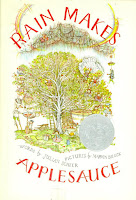 Imagine a City is the gorgeously unforgettable picture book by Elise Hurst that reminds me of a childhood favorite, Rain Makes Applesauce, a 1964 Caldecott honor book by Marvin Bileck and Julian Scheer. Imagine a City begins with a gentle voice inviting readers to, "Imagine a train to take you away / Imagine a city and drops of rain / A world without edges / Where the wind takes you high."
Imagine a City is the gorgeously unforgettable picture book by Elise Hurst that reminds me of a childhood favorite, Rain Makes Applesauce, a 1964 Caldecott honor book by Marvin Bileck and Julian Scheer. Imagine a City begins with a gentle voice inviting readers to, "Imagine a train to take you away / Imagine a city and drops of rain / A world without edges / Where the wind takes you high."Hurst's illustrations are rooted in reality, but the world she creates is filled with magic and wonder. And there are little details everywhere to be discovered, including nods to great surrealist painters like Rene Magritte, as seen in the illustration below.
Imagine a City is a book that is perfect for sending little listeners off into dreamland, but also a marvelous springboard for imagination. The next rainy or snowy day, be sure to pull this book off the shelf and inspire your children to create their own "world without edges."
Source: Review Copy
 Rabbit & Robot and Ribbit is the newest chapter book from the marvelously silly Cece Bell. In Rabbit & Robot: The Sleepover we first met the two friends working out their differences at their first sleepover. The best beginning reader chapter books seem to be those where friends work out their differences and/or their differences make for a stronger friendship. Bell brings all of that and more to her fantastic chapter books.
Rabbit & Robot and Ribbit is the newest chapter book from the marvelously silly Cece Bell. In Rabbit & Robot: The Sleepover we first met the two friends working out their differences at their first sleepover. The best beginning reader chapter books seem to be those where friends work out their differences and/or their differences make for a stronger friendship. Bell brings all of that and more to her fantastic chapter books.

In Rabbit & Robot and Ribbit, jealousy is at the heart of the story. Robot has a new friend, Ribbit, and Rabbit is feeling left out. Especially since the only word that Ribbit says is "ribbit." However, "ribbit" means much more than just "ribbit," but only Robot can, using his Built-in Frog Glossary, translate. Bell layers on the wordplay, with Robot telling Rabbit that he is "engrossed" in something and Rabbit responding, "Gross!" Rabbit and Ribbit connect over their love of the television show Cowboy Jack Rabbit but clash again when Ribbit wants to be Cowboy Jack Rabbit in their pretend play. Ribbit is a girl and everyone knows girls can't be Cowboy Jack!
Through it all, the three manage to work things out, although it takes Robot overheating and falling over for Rabbit and Ribbit to truly bond. There are context clues and picture clues that will help emerging readers as they laugh their way through this fun new book and be ready for the next book in this super series!
Source: Review Copy
I really like cryptids. They are a universal creation, from the Mongolian Death Worm to the Scottish born Loch Ness Monster to the Chupacabra of Mexico, every culture seems to have a mythical creature that some people believe is not mythical. And, because they are (probably?) mythical, authors and illustrators are free to give cryptids any kind of personality traits and back story they want. Finally, with Brittany R. Jacobs's new picture book, The Kraken's Rules for Making Friends, this fantastic cryptid is getting attention that unicorns, Big Foot and the yeti have been monopolizing.
Jacobs has a great take on the trouble with being a kraken, most notably the challenge of making friends. When you are a giant squid, this just doesn't come easily. The kraken tries to be more approachable by knitting a koi fish costume that doesn't fool anyone.
The kraken seeks out advice from the great white shark who, oddly enough, seems to be a pro at making friends. The kraken follows all of the shark's rules, but still no joy. Finally, the kraken realizes that there is one fellow who he can bond with, and a chum is made.
Jacobs's illustrations are cinematic and cartoonish at the same time, which makes for a very animated story. Her palette is limited but lovely. Best of all, Jacobs manages to make a giant squid cute and even cuddly and very expressive. I can't wait to see what cryptid or creature Jacobs takes on next!
Soure: Review Copy
We Found a Hat by Jon Klassen is the final book in what has come to be known as the Hat Trilogy. While not the ending I might have anticipated or hoped for, it IS a very satisfying and perfect finale to what are possibly the two funniest, smartest, best picture books I have read. 
I don't want to give away the plot because, as with all books in this trilogy, it is a delight to discover on first read. But, I can tell you that We Found a Hat is the story of two turtles who both look really good in the hat that they find in their sparse desert landscape. I Want My Hat Back and This Is Not My Hat (which I didn't review because I was working for Klassen's agent when it came out) and We Found a Hat all deal with envy - hat envy, to be specific. Klassen takes a different approach to this envy in this new book in a way that solidifies his status as a superb author and illustrator.
The book trailers for all three books in the series, especially We Found a Hat, with Burl Ives singing Home on the Range in his sonorous, rich voice, are fantastic. I'm assuming that anyone reading this review is familiar with the Hat Trilogy, so enjoy this walk down memory lane!
Source: Review Copy
Under Earth, Under Water by Aleksandra Mizielińska and Daniel Mizieliński is their fourth book I have reviewed here and their fourth book with the marvelous Big Picture Press, a publisher of oversized, highly illustrated, gorgeous books who believe that books should be "visually intelligent, surprising, and accessible to readers of all ages, abilities and nationalities." BPP definitely achieves this with every book they publish and, if you are a book lover, you will want to seek out all their titles. Under Earth, Under Water will appeal to anyone who likes to look inside things and understand how things work.
With Under Earth, Under Water, the Mizielińskis, who have an illustration style that is filled with tiny details and a unique palette, take readers on a detailed journey, from the top of the page to the bottom, over and under land and then sea. The endpapers serve as the introduction and table of contents, with images scattered across the spread, page numbers connecting them like a dot-to-dot. The introduction tells readers that "you will meet cavers, spelunkers, miners and passengers on the subway. You will find fossilized dinosaur bones, ancient relics, and gold! Lower yourself deeper and deeper down, from the thinnest layer of soil just beneath your feet all the way to Earth's red-hot core." From bugs and burrowing animals, we head on to edible roots and more. Everything is labeled, and there is a chunky paragraph of information on each page as well as textural details throughout. Leaving the natural world, readers move onto human constructions underground like subways and mines and a very cool spread on mined resources and how we use them. From there, paleontological finds, archaeological finds and caves are explored. This leads perfectly into how volcanoes are made, how geysers are made, the layers of the earth and tectonic plates.


With perfect logic, the center spread of Under Earth, Under Water, is of the Earth's core, with the text orientation flipping to indicate the need to flip the book itself. The endpapers tell readers that they will meet "record-breaking divers, scientists and research vessels" and come across "weird creatures of the deep, vintage submarines, and the wreck of the Titanic" before diving deeper down to explore "coral reefs bathed in sunlight the deepest part of the ocean, plunged in cold and darkness."
From lakes to the ocean and a look at buoyancy, to coral reefs, sinkholes, a look at pressure, diving and record breaking divers, a history of diving suits and submarines, the experience of reading Under Water has a very different feel, despite the continuous illustration style. I felt like I was going deeper and deeper underwater with every page turn and, being a tiny bit claustrophobic, I felt my breath tighten a bit. Giant sea creatures of the deep, underwater chimneys and deep sea dwellers are explored along with oil and gas platforms, the Mariana Trench, scientists underwater and the Deep Sea Challenger. The final pages of Under Water were most fascinating to me, with a look at the Mariana Trench and the Deep Sea Challenger, which is almost 7 miles under water!
Under Earth, Under Water is a magnificent book that any curious reader, young or old, will spend hours poring over. And, it's sure to spark an interest in new and exciting things, below ground and under water!
Source: Review Copy
3 Reasons Why You Need to Buy This Book:
1) DIVERSITY
2) Visual Appeal
3) This list rocks
I almost feel like I don't need to write a review of 101 Books to Read Before You Grow Up by Bianca Schulze, founder of The Children's Book Review, especially since I include the Table of Contents and a sample page here. Look at them, and you see the validity of my three reasons for buying this book. But, I feel like I do need to say one specific thing about 101 Books to Read Before You Grow Up - this book is designed to appeal to kids from ages 4 - 11 (see a guest post from Schulze below on the great reason for this age cap), from the great graphics to the small trim size to the chunks of information on each page. Kids will be drawn to this book, pick it up, flip through it and find more than a few books they want to read - especially thanks to Schulze's excellent "What to Read Next" list that accompanies every title. And, as parents, I think we need to admit that our kids don't always want to read a book we put in their hands. I have MUCH better luck getting one of my students to read a book I like than I do my own 12-year-old-son. For those of us who read, of course we want our children to read books we like, but what we really want if for that passion to be sparked in our children, driving them to seek out books on their own. 101 Books to Read Before You Grow Up will spark this passion!

I do also want to speak briefly to the diversity of characters and settings represented in Schulze's book. While the world of American children's books still has far to go, there have been advances made in bringing diversity to the page and Schulze's list shows that, at ever reading level. From obvious choices like this year's multiple award winner Last Stop On Market Street to titles like Henry's Freedom Box: A True Story from the Underground Railroad, Anna Hibiscus, Mango, Abuela and Me, Crossing Bok Chitto: A Choctaw Tale of Friendship and Freedom, The Year of the Dog, George, Rickshaw Girl, The Crossover, The Watsons Go to Birmingham, One Crazy Summer, The Birchbark House, Inside Out and Back Again, A Long Walk to Water, Roll of Thunder Hear My Cry and Esperanza Rising. There are also books about kids facing physical challenges like El Deafo, Out of My Mind, and Wonder. There are also plenty of books about the immigrant experience, which you can discover by looking at the Titles By Genre section at the end of the book that is FANTASTIC! I will say, though, that I think the important inclusion of books with diverse characters probably limited the number of books fantasy books that were included - white kids as main characters pretty much dominate the middle grade fantasy genre... And, as a lover of all things kid's books, I was very pleased to find more than one verse novel on the list (and HOW HARD was it to leave Brown Girl Dreaming off the list??) as well as two graphic novels, El Deafo and The Arrival. 
I hope you will read this guest post that Schulze wrote for books4yourkids.com!
101 Books to Read Before You Grow Up … And 101+ More
“As a child, my family’s menu consisted of 2 choices: take it or leave it.”—Buddy Hackett, American comedian and actor
Which books did not make the list of 101 books to read before a child grows up?
One of my biggest fears I had when creating this book was … creating this book. Coming up with the 101 books that I feel that kids should read before they grow up was absolutely no easy feat. With so many tremendous books to choose from, I took this job very seriously. I wanted as many children as possible to be able to use it as a guidebook for finding a story that they could see themselves in. I wanted kids to be able to read stories about characters, places, and situations that would provide them with a greater love and understanding for the world around them and the people in it. Most importantly, I wanted (and want) kids to find stories that they enjoy reading!
Sure, my day job is sorting through the many published children’s books available and then featuring the best of the best on The Children’s Book Review, but it’s a never-ending (hopefully) accumulation of book sharing. If I have missed a great book that published a year ago, I can always add it. If I love a book so much that I can’t stop talking about it, I can share it in as many articles as I wish. Writing 101 Books to Read Before You Grow Up: The must read book list for kids (Walter Foster Jr. 2016) meant that I was providing a definitive list, and a list that touts it is the must-read book list for kids. No pressure, right? I can’t say for sure, but the original list—which was spread across post-it notes, spreadsheets, an iPhone note, Facebook comments from friends, and e-mails from my editor at Quarto Kids—was a couple of hundred books long. With the help of my editor and the Quarto publishing team, I was able to get the list down to 101 books that I would, forever more, recommend as must-read titles to my own kids and yours.
But, what were the books I left out? Too many to list here, but I made the decision, with the support of my editor, to create a list that was capped at books for ages 11 and under. Once we introduce books for 12 and up, we enter the world of young adult novels. As a parent of 3 children (currently ages 1, 4, and 10), while I wanted to include stories that challenge the readers emotions (be it through humor or sadness), I also wanted to make sure our picture book readers weren’t going to stumble upon content that was too far beyond them. Once I made this decision, I had to make some cuts that snowballed (thankfully) into justified cuts of other books.
Then there were my all-time favorite authors like Judy Blume and Roald Dahl. I could have included all of their books, but then the list would not have been diverse enough. However, I did find a sneaky way to add more of my fave books from my fave authors. With each of the 101 books there is also a “You may also like:” section. I was able to sneak in plenty more of my favorite books that may otherwise not have been mentioned within the pages. The title of the book could also be: 101 Books to Read Before You Grow Up … and 101+ More.
Here are a few that would have, should have, could have made the list:
To Kill a Mocking Bird, by Harper Lee
The Boy with the Striped Pajamas, by John Boyne
I Know Why the Caged Bird Sings, by Maya Angelou
The Catcher in the Rye, by J.D Salinger
Lord of the Flies, by William Golding
The Magic Faraway Tree, by Enid Blyton
And everything by Dr. Seuss.
Now let me ask you: What would you have included or excluded in your list of 101 books for kids to read before they grow up?
Source: Review Copy
Little Bot and Sparrow by Jake Parker is a sweet, quiet picture book that got me a little choked up at the end. In fact, Parker's book thematically calls to mind picture book author and illustrator Peter Brown's debut children's novel, The Wild Robot. Great minds do think alike...

Little Bot and Sparrow, which has a fantastic book case showing the blue prints for Little Bot on the front and Sparrow on the back, begins its story on the title page where we see a space ship flying over a snowy landscape and jettisoning something. That something is Little Bot, who is "thrown out with the garbage" when he isn't needed any more. Alone in a new environment, he tries to make friends with a flock of birds. All but one fly off in fear. Curious, a sparrow watches and eventually befriends Little Bot, seeing that he just needs to be "taken under her wing." Sparrow teaches Little Bot about the world around him, and he is a quick learner. When he questions her about why she needs to sleep, she replies, "To rest and to dream." Not needing to sleep and not knowing what it means to dream, Little Bot decides that it is best left to the birds.

As winter approaches, Little Bot knows that it is time to say goodbye, and he does so with a tear in his eye. He watches her fly off with her flock until she is only a "tiny dot in the sky," then he wanders past places they explored, wondering if she is safe. That night, Little Robot closes his eyes for the first time. And he dreams.
Little Bot and Sparrow can be read and enjoyed on more than one level, making it even more meaningful. Parker's illustrations are absolutely gorgeous, with a soft edge that echoes the story. Scenes from the natural world are often filled with humor and playfulness, while Little Bot is presented as almost human in form and never threatening. That glimpse of the space ship on the title page made me want to know more about the world that Little Bot came from. Maybe next time?
Source: Review Copy
View Next 25 Posts


.jpeg)













